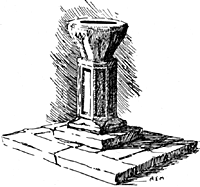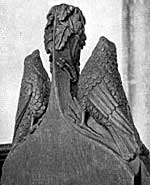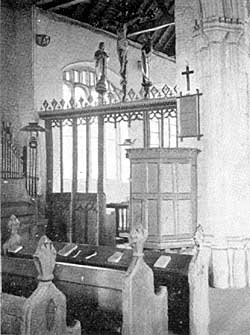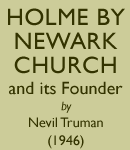BUILDING THE CHURCH
The Norman church had probably a dark aisleless nave and a low chancel. All that remains of it is the north wall of nave and chancel and the lower part of the cast wall of the choir which still bears the string course with chevron ornament which ran beneath the Norman window sill. This part was built between 1150 and 1200.
In the Early English period the north door was inserted, between 1200 and 1225.
In the Decorated period the tozver was built, between 1250 and 1350.
When John Barton decided to enlarge the church he found this aisleless building and tower. He inserted windows in the choir and a west window and buttresses to the tower with a new tower arch and pulled down all the south side, adding the Lady Chapel and south aisle. This was in the Perpendicular period, about 1485.
His descendant Robert may have inserted the row of shields in the south porch, about 1550.
The seventeenth century gave us the altar rails, about 1620- 30, and the 'spider' candelabra in the nave, about 1690-1710.
The eighteenth century was responsible for the loss of the Tudor roofs, which were flat pitched and of some beauty. The present high-pitched brick, plaster and red pantiled roof, and the brick buttresses of the north side were built to support its heavy lean outwards.
A CONDUCTED TOUR
This guide commences at the west end by the font, passes up the centre aisle, through the choir, into the Lady Chapel, down the south aisle, into the porch room and thence outside turning to the left and passing along the south side, round the east end and so hack to the porch, past the tower.
THE NAVE

The Font is of almost classic simplicity with recessed panels on its eight sides. Its oak cover (1938) has a low spire of scrolls surmounted by a coloured and gilt statuette of St. Giles.
The Parish Chests. There is an old oak chest plainly moulded, without carving. Its interest lies in the fact that it is divided vertically into two compartments with separate lids to either side. It is now used for the altar linen.
In the porch room there is an eighteenth-century chest with a fragment of fifteenth-century coped lid, all bound in iron.
The great chest was kept in each church for storing the parishioners' wills before safes were common. As the Prayer Book rubric reminds us, it is the duty of the parish priest to see that his sick parishioners duly make their wills.
Candelabra. In turning over a pile of rubbish in the porch room the author discovered a piece of turned wood black with dirt, and near by, four carved branches of what looked like rusty iron. He recognized them as parts of a candelabrum of the type nicknamed 'spider' because of its fat body and sprawling legs. They were cleaned, painted and plated and form a rather rare specimen as most of these lights were made of brass. This one is of elm and steel and hangs at the west end.
The Tower Screen. Before 1934 the tower vestry was concealed by a shabby red felt curtain. The present screen was inserted at the restoration and is made from oak pew panels which came from another Church. On the top may be seen two massive Jacobean oak urns which once doubtless choir stalls in Attenborough Church, but were turned out when new stalls were made. They were preserved from loss by the author who secured them for Holme Church in 1932. Holes still remain on their tops from which golden 'flames' must have sprung. Note the new hand-made iron door handle.
North Door. The nail head enrichment on the capitals outside, and its plain chamfered arch, show it to be Early English in style and of date 1200-1225. It is double, unusual in so small a door. The sill was discovered to be the shaft of a churchyard cross, with mouldings at each angle.
The north door was in constant use in the Middle Ages for the weekly procession before the Sunday Mass and during the ceremonies of baptisms and funerals.

The Eagle carving.
Pews. The pews are just as John Barton left them, though most of the poppy-heads are very much worn. Notice the wide spaces left at the west end and in the alleys, adding much dignity to the building. It is a great modern mistake to fill a church completely with seats and the mediaeval builders never forgot the beauty and value of open areas. The centre-block heads are larger than those on the side blocks.
The Marriott Slab. In the floor near the rood screen is a small brass tablet in memory of John Randolph, son of the Rev. Randolph Marriott and Anne, his wife. He died of typhus fever 6th March, 1812, when only in his fourteenth year.
The Pulpit by John Burton, F.R.I.B.A., incorporates Jacobean panels from Dean Hole's pulpit at Caunton once used as a summer house but rescued and given by his son Major Hugh Hole.
Priest's Door by Lady Chapel Screen. This had almost disintegrated and was only held up by being plastered on the inside. A new oak door was made but only an inch of carved tracery remained, the lost parts had, through the ages, been "photographed" by the sun on to the door, and these faint fade marks permitted the whole design to be recovered. Note the new hand-made iron handle, a copy of a 15th Century one.
THE ROOD SCREEN

The rood screen and pulpit.
The Rood Screen was in a sad state of neglect and dilapidation, all its carved tracery lost save for that in the north light next the door. To supply what was lost, carvings had been torn from the front of the Lady Chapel stalls and rammed into the rood screen. They neither fitted nor matched—great gaps showing—and were put in so unintelligently that the uncarved side was in front instead of behind! The horizontal beam across the top was of pitch pine on top of which were nailed pieces of broken cresting, and deal and pine patchings had been made.
In 1934 the pine beam was replaced by a massive oak one with mouldings copied from the similar one in the Lady Chapel. The base panels were filled in, the intruded tracery restored to the Lady Chapel stalls and fresh tracery, copied from the original portion remaining, was placed in the screen to supply the long empty gaps.
On the east side can be seen remains of the arms of the return stalls which have now again been supplied.
All the woodwork in the Church is fifteenth-century work.
The Rood and attendant figures of Our Lady and St. John, coloured and gilt, were given in 1938, the donors' arms being painted on a base panel. The two screens across the church are coloured and gilt, the new gilt cresting being based on the old work.
THE CHANCEL
High up on the left wall will be seen three corbels which supported the former roof timbers. They are carved with shields, two of them being the merchant's mark which John Barton used for his bales of wool as a kind of trade mark. The middle one shows the arms of the merchants of the Staple of Calais.
It is amusing to notice that the three opposite corbels which are on the dark side of the choir, have never been carved, the founder evidently (as a big business magnate) not approving of spending money on what did not show! All were painted and gilded in 1934, their colours having disappeared.
On either side of the high altar is a bracket for a small image. Usually the patron saint is placed in this position, as was done in 1938, St. George occupying the other bracket, it adds a welcome touch of colour to the east wall and links up the window and altar better.
The Altar Rails are early seventeenth century and were in 1932 covered with ugly brown paint and grained. On stripping these, green paint was found and finally fine oak. It will be seen that at a later time certain balusters have been carefully copied and renewed. The top rail is modern. Altar rails were ordered by Archbishop Laud so as to protect the altar from dogs in the days when they went to church with their masters.
Standard Candlesticks. The wrought iron standard candlesticks before the high altar are late fifteenth or early sixteenth century and so contemporary with the building. Made for processional gospel lights they were bought by the author and are now used once more for their first sacred purpose, and are rare. There is nothing like them even in the South Kensington Museum.
The High Altar is a Georgian oak table of uninteresting design. Owing to its small size it was lengthened in 1934 and is now adorned with a frontal, riddel curtains and dossal of linen in an old Portuguese design and beautiful colouring.
The sanctuary had been raised (probably in the nineteenth century) so that the base of the tomb was hidden and the proportions of the east wall spoilt. The original level was restored in 1933 when the tomb-shields on the floor level were again brought to light, still covered with lime-wash. The old stones were used for the foot-pace and preserve the air of antiquity so valuable.
The silver crucifix was given in memory of Dr. Percy Truman, Ll.D., of Nottingham and Newark, and is of Flemish seventeenth-century work with a Renaissance Charles II base. This very fine work, once in a church, was taken to a shop and abandoned till it was found and secured by the author. Six silver plated Renaissance style candlesticks from Bruges have been added.
Altar Plate. Pewter flagon by Thomas Powell or Palmer, c. 1740. Pewter footed paten by Roger Bancks, c. 1720. Silver chalice and paten plain, possibly 1545.
